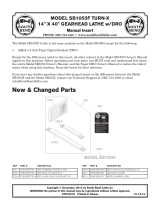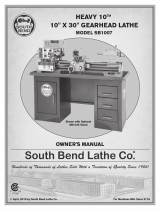Page is loading ...

WORLD
PRECISION
INSTRUMENTS
PUL-1000
Microprocessor-controlled micropipette puller
Serial No._____________________
www.wpiinc.com
FACTORY SET PROGRAMS COOKBOOK
030321


PUL-1000 (Factory Set Programs)
World Precision Instruments i
Copyright © 2021 by World Precision Instruments. All rights reserved. No part of this publication may
be reproduced or translated into any language, in any form, without prior written permission of World
Precision Instruments.
CONTENTS
ABOUT THIS MANUAL ................................................................................................................... 1
INTRODUCTION .............................................................................................................................. 1
FACTORY SET PROGRAMS ............................................................................................................ 2
Program 00 (Long Graduated Taper, 1.0 mm Glass) ....................................................... 3
Program 01 (Short Graduated Taper, 1.0 mm Glass) ...................................................... 4
Program 02 (Short Taper, 1.0 mm Glass)............................................................................ 5
Program 10 (Long Graduated Taper, 1.14 mm Glass) ..................................................... 6
Program 11 (Short Graduated Taper, 1.14 mm Glass) .................................................... 7
Program 12 (Short Taper, 1.14 mm Glass) ......................................................................... 8
Program 20 (Long Graduated Taper, 1.2 mm Glass) ....................................................... 9
Program 21 (Short Graduated Taper, 1.2 mm Glass) ....................................................10
Program 22 (Short Taper, 1.2 mm Glass)..........................................................................11
Program 30 (Long Graduated Taper, 1.5 mm Glass) .....................................................12
Program 31 (Short Graduated Taper, 1.5 mm Glass) ....................................................13
Program 32 (Short Taper, 1.5 mm Glass)..........................................................................14
Program 40 (Long Graduated Taper, 2.0 mm Glass) .....................................................15
Program 41 (Short Graduated Taper, 2.0 mm Glass) ....................................................16
Program 42 (Short Taper, 2.0 mm Glass)..........................................................................17
BACKGROUND INFORMATION .................................................................................................. 18
MY CUSTOM SEQUENCES ..........................................................................................................19

ii World Precision Instruments

PUL-1000 (Factory Set Programs)
World Precision Instruments 1
ABOUT THIS MANUAL
The following symbols are used in this guide:
This symbol indicates a CAUTION. Cautions warn against actions that can cause
damage to equipment. Please read these carefully.
This symbol indicates a WARNING. Warnings alert you to actions that can cause
personal injury or pose a physical threat. Please read these carefully.
NOTES and TIPS contain helpful information.
INTRODUCTION
PUL-1000 is a microprocessor controlled, up to four-stage, horizontal puller for
making glass micropipettes or microelectrodes used in intracellular recording,
patch clamp, microperfusion and microinjection. The puller was designed with tight
mechanical specications and precision electronics for complete control of the pulling
process and accurate reproducibility. It oers programmable sequences of up to
four steps with HEAT INDEXing, FORCE (g), movement and cooling time. This allows
graduated cycles for a variety of applications.
NOTE: This is a puller educational and research purposes, not a production puller. If
the puller stops in the middle of a pull as a result of overHEAT INDEXing, allow time for
it to cool down.
For information on using the PUL-1000, please refer to the Instruction Manual found
at www.wpiinc.com/manuals.
NOTE: The glass melting point is also referred to as the glass softening point.

2 World Precision Instruments
FACTORY SET PROGRAMS
Program
Glass OD
(mm)
Long
Graduated
Taper
Short
Graduated
Taper
Short
Taper (Bee
Stinger)
Expected
Ave. Tip
Diameter
(µm) Glass SKU Page
00 1.0 X 0.5~1 1B100-4 3
01 1.0 X 1~2 1B100-4 4
02 1.0 X 2~3 1B100-4 5
10 1.14 X 0.5~1 504949 6
11 1.14 X 1~2 504949 7
12 1.14 X 2~3 504949 8
20 1.2 X 0.5~1 1B120-4 9
21 1.2 X 1~2 1B120-4 10
22 1.2 X 3~4 1B120-4 11
30 1.5 X 0.5~1 1B150-4 12
31 1.5 X 1~2 1B150-4 13
32 1.5 X 2~4 1B150-4 14
40 2.0 X 0.5~1 1B200-4 15
41 2.0 X 2~4 1B200-4 16
42 2.0 X 2~4 1B200-4 17

PUL-1000 (Factory Set Programs)
World Precision Instruments 3
Program 00 (Long Graduated Taper, 1.0 mm Glass)
Average glass softening point for 1 mm glass (1B100-4, Lot# 2209343) = 515°C @ ~ 66-74% humidity and ~70-73°F
STEP HEAT INDEX FORCE (g) DISTANCE (mm) DELAY (0.1 s) TIP GEOMETRY
1 650 250 8.00 0 Long graduated taper (tip
break back needed)*
2----
3----
4----
*NOTE: To make a large tip
(usually > 5 µm tip), break o
the nal tip. Use a breaking
back technique using blades or
tweezers, or drag the tip on a
Kimwipe. A second process such
as beveling and/or re polishing
may also be needed.

4 World Precision Instruments
Program 01 (Short Graduated Taper, 1.0 mm Glass)
Average glass softening point for 1 mm glass (1B100-4, Lot# 2209343) = 515°C @ ~ 66-74% humidity and ~70-73°F
STEP HEAT INDEX FORCE (g) DISTANCE (mm) DELAY (0.1 s) TIP GEOMETRY
1 650 250 2.00 100
2 400 300 7.00 0 Short graduated taper
3----
4----

PUL-1000 (Factory Set Programs)
World Precision Instruments 5
Program 02 (Short Taper, 1.0 mm Glass)
Average glass softening point for 1 mm glass (1B100-4, Lot# 2209343) = 515°C @ ~ 66-74% humidity and ~70-73°F
STEP HEAT INDEX FORCE (g) DISTANCE (mm) DELAY (0.1 s) TIP GEOMETRY
1----
2----
3----
4 510 250 0.60 100 Short taper (bee stinger)

6 World Precision Instruments
Program 10 (Long Graduated Taper, 1.14 mm Glass)
Average glass softening point for 1.14 mm glass (504949, Lot# 02K) = 576°C @ ~ 66-74% humidity and ~70-73°F
STEP HEAT INDEX FORCE (g) DISTANCE (mm) DELAY (0.1 s) TIP GEOMETRY
1 650 250 8.00 0 Long graduated taper (tip
break back needed)*
2----
3----
4----
*NOTE: To make a large tip
(usually > 5 µm tip), break o
the nal tip. Use a breaking
back technique using blades or
tweezers, or drag the tip on a
Kimwipe. A second process such
as beveling and/or re polishing
may also be needed.

PUL-1000 (Factory Set Programs)
World Precision Instruments 7
Program 11 (Short Graduated Taper, 1.14 mm Glass)
Average glass softening point for 1.14 mm glass (504949, Lot# 02K) = 576°C @ ~ 66-74% humidity and ~70-73°F
STEP HEAT INDEX FORCE (g) DISTANCE (mm) DELAY (0.1 s) TIP GEOMETRY
1 650 250 2.00 100
2 410 300 7.00 0 Short graduated taper
3----
4----

8 World Precision Instruments
Program 12 (Short Taper, 1.14 mm Glass)
Average glass softening point for 1.14 mm glass (504949, Lot# 02K) = 576°C @ ~ 66-74% humidity and ~70-73°F
STEP HEAT INDEX FORCE (g) DISTANCE (mm) DELAY (0.1 s) TIP GEOMETRY
1----
2----
3----
4 485 250 0.60 100 Short taper (bee stinger)

PUL-1000 (Factory Set Programs)
World Precision Instruments 9
Program 20 (Long Graduated Taper, 1.2 mm Glass)
Average glass softening point for 1.14 mm glass (1B120-4, Lot# 04J) = 517°C @ ~ 59-67% humidity and ~70-73°F
STEP HEAT INDEX FORCE (g) DISTANCE (mm) DELAY (0.1 s) TIP GEOMETRY
1 650 250 8.00 0 Long graduated taper (tip
break back needed)*
2----
3----
4----
*NOTE: To make a large tip
(usually > 5 µm tip), break o
the nal tip. Use a breaking
back technique using blades or
tweezers, or drag the tip on a
Kimwipe. A second process such
as beveling and/or re polishing
may also be needed.

10 World Precision Instruments
Program 21 (Short Graduated Taper, 1.2 mm Glass)
Average glass softening point for 1.14 mm glass (1B120-4, Lot# 04J) = 517°C @ ~ 59-67% humidity and ~70-73°F
STEP HEAT INDEX FORCE (g) DISTANCE (mm) DELAY (0.1 s) TIP GEOMETRY
1 650 250 2.00 100
2 370 300 7.00 0 Short graduated taper
3----
4----

PUL-1000 (Factory Set Programs)
World Precision Instruments 11
Program 22 (Short Taper, 1.2 mm Glass)
Average glass softening point for 1.14 mm glass (1B120-4, Lot# 04J) = 517°C @ ~ 59-67% humidity and ~70-73°F
STEP HEAT INDEX FORCE (g) DISTANCE (mm) DELAY (0.1 s) TIP GEOMETRY
1----
2----
3----
4 430 250 0.60 100 Short taper (bee stinger)

12 World Precision Instruments
Program 30 (Long Graduated Taper, 1.5 mm Glass)
Average glass softening point for 1.5 mm glass (1B150-4, Lot# 2208332) = 629°C @ ~ 61-70% humidity and ~70-73°F
STEP HEAT INDEX FORCE (g) DISTANCE (mm) DELAY (0.1 s) TIP GEOMETRY
1 700 250 8.00 0 Long graduated taper (tip
break back needed)*
2----
3----
4----
*NOTE: To make a large tip
(usually > 5 µm tip), break o
the nal tip. Use a breaking
back technique using blades or
tweezers, or drag the tip on a
Kimwipe. A second process such
as beveling and/or re polishing
may also be needed.

PUL-1000 (Factory Set Programs)
World Precision Instruments 13
Program 31 (Short Graduated Taper, 1.5 mm Glass)
Average glass softening point for 1.5 mm glass (1B150-4, Lot# 2208332) = 629°C @ ~ 61-70% humidity and ~70-73°F
STEP HEAT INDEX FORCE (g) DISTANCE (mm) DELAY (0.1 s) TIP GEOMETRY
1 700 250 2.00 100
2 440 300 7.00 0 Short graduated taper
3----
4----

14 World Precision Instruments
Program 32 (Short Taper, 1.5 mm Glass)
Average glass softening point for 1.5 mm glass (1B150-4, Lot# 2208332) = 629°C @ ~ 61-70% humidity and ~70-73°F
STEP HEAT INDEX FORCE (g) DISTANCE (mm) DELAY (0.1 s) TIP GEOMETRY
1----
2----
3----
4 500 250 0.60 100 Short taper (bee stinger)

PUL-1000 (Factory Set Programs)
World Precision Instruments 15
Program 40 (Long Graduated Taper, 2.0 mm Glass)
Average glass softening point for 2.0 mm glass (1B200-4, Lot# 2108325) = 645°C @ ~ 61-70% humidity and ~70-73°F
STEP HEAT INDEX FORCE (g) DISTANCE (mm) DELAY (0.1 s) TIP GEOMETRY
1 750 250 8.00 0 Long graduated taper (tip
break back needed)*
2----
3----
4----
*NOTE: To make a large tip
(usually > 5 µm tip), break o
the nal tip. Use a breaking
back technique using blades or
tweezers, or drag the tip on a
Kimwipe. A second process such
as beveling and/or re polishing
may also be needed.

16 World Precision Instruments
Program 41 (Short Graduated Taper, 2.0 mm Glass)
Average glass softening point for 2.0 mm glass (1B200-4, Lot# 2108325) = 645°C @ ~ 61-70% humidity and ~70-73°F
STEP HEAT INDEX FORCE (g) DISTANCE (mm) DELAY (0.1 s) TIP GEOMETRY
1 750 250 3.50 100
2 470 350 7.00 0 Short graduated taper
3----
4----
/















